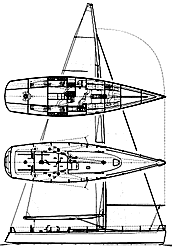Nelson/Marek IMS 60
IMS Racer-Cruiserr
This Nelson/Marek 60-footer is a perfect example of a good all-around performer with emphasis on boat speed rather than on a static, rated speed. Boat speed endures while rated speed can be fleeting if the rule changes. This boat was designed to be big enough to compete for line honors on offshore events while being small enough to race around the buoys without an army of a crew.
The hull form is typical of an IMS boat but the proportions have been tweaked to put the 60 right in between the downwind sleds and the windward-leeward type racers. This means that the boat will be slightly oriented toward off-the-wind races but will have the power to go to weather well. The rudder is tucked well under the counter. The D/L is 86.96. Draft is a healthy 12 feet with almost 45 percent of the boat's displacement in ballast. The keel fin is cast iron with all the lead in the bulb. The daggerlike rudder blade and stock are carbon fiber.
I like this interior layout. It is very conventional with the galley aft and the engine under the cockpit. While this might not be the optimum racing layout in terms of weight distribution, it will make this boat more user-friendly in terms of the feel below. This design has a real saloon that will be a nice place for the crew to gather after the race and swap lies. Note that the center island of the drop-leaf table doubles as a drink cooler and a sturdy handhold while moving below in a seaway. As usual, I'd like to see more counter space in the galley, but for a racing yacht this is a great galley. The nav station is generous and faces aft to make it easier for the navigator to talk to the cockpit crew. The quarter cabins are adjacent to the engine box. There are crew lockers aft of the engine space on centerline. The Nelson/Marek office does a great job styling its high-tech interiors.
The rig features swept spreaders and the angle at the deck from the centerline of the spar to the chainplates is 25 degrees. This will make for a rigid stick and should eliminate the need for runners. This high sweep angle will also make sheeting the jib very easy. No overlapping headsails will be carried. The split backstay is fixed and headstay tension is controlled by a short-stroke hydraulic cylinder actuated from the cockpit. The mast is carbon fiber. The simplicity of this four-spreader rig offsets the cost of the carbon-fiber spar. The SA/D is 33.68.
The deck layout features a two-wheel cockpit with pedestal winches for headsail, spinnaker and mainsheet. The mainsheet winch is located on the centerline island along with the hydraulic controls. Crew weight is kept well forward in this deck layout, while there is room aft of the wheels for a couple of guests to observe the action without getting in the way.
If you compare this boat to the typical IOR 60-footer of 15 years ago with its pinched ends, restricted draft, floppy spar, huge genoas, skinny mainsail and minimal righting moment, you will see just how far we have come. This wonderful boat will be fun and easy to sail while being adaptable to a wide range of family uses.

Comments